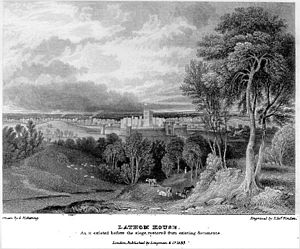Siege of Lathom House
| Siege of Lathom House | |||||||
|---|---|---|---|---|---|---|---|
| Part of the First English Civil War | |||||||
 Illustration of Lathom House, prior to the siege |
|||||||
|
|||||||
| Belligerents | |||||||
| Royalists | Parliamentarians | ||||||
| Commanders and leaders | |||||||
| 1st: Countess of Derby 2nd: Col. Edward Rawstorne |
1st: Sir Thomas Fairfax 2nd: Col. Peter Egerton |
||||||
| Strength | |||||||
| 1st: 300 | 1st: 2,000 2nd: 4,000 |
||||||
| Casualties and losses | |||||||
| 1st: Less than 10 | 1st: 400–500 | ||||||
The Siege of Lathom House was a military confrontation between a Parliamentarian army and a Royalist stronghold in Lathom near Ormskirk in Lancashire, during the First English Civil War. The first lasted from late February to late May 1644, when the siege was lifted. The second siege took place a year later from July to December 1645. Lathom House was captured and slighted.
James Stanley, 7th Earl of Derby, was the leading Royalist adherent in the northwest of England when the civil war broke out in 1642. The family seat of the Stanleys was Lathom House. In 1643, the Earl of Derby was ordered by King Charles to fortify the Isle of Man against a possible Scottish invasion, and then move on to the northern campaign. His wife, Charlotte de la Tremoüille, was left in charge of what turned out to be the last remaining Royalist stronghold in Lancashire. Sir Thomas Fairfax saw Derby's absence as an opportunity to strengthen the Long Parliament's position in Lancashire and set out to conquer Lathom House. Immediately after the fall of Warrington, the Parliamentarians requested that the countess acknowledge Parliament's authority and surrender her house, but she refused on the grounds that doing so would dishonour her husband. She offered to limit herself to defending her home, and this postponed further attacks on her position.
When Fairfax arrived at Lathom House in February 1644, the Countess had made every effort to conceal the strength of the castle's fortifications. Fairfax demanded that the Countess surrender Lathom House to him. She asked for a week to consider his offer, and then insisted that it was only appropriate that he visit her at Lathom House for further negotiations. He was received as an honoured guest, but the entire household categorically rejected his terms for surrendering. He gave her two more days to consider her situation. The emissary sent two days later was scornfully dismissed.
...
Wikipedia
